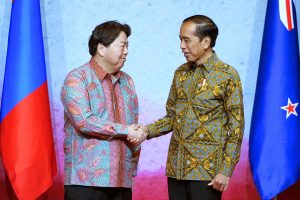This year is the 50th anniversary of ASEAN-Japan relations, which have been marked by a growing interdependence. Although ASEAN only accounts for 3.6 percent of the global economy, it is home to 30 percent of all Japanese overseas subsidiaries. Japanese capital investment in ASEAN is far greater than the region’s economic clout would suggest.
The source of ASEAN’s growth lies in industrialization and exports driven by foreign direct investment. Japanese companies that have expanded into ASEAN play a significant role as corporate citizens contributing to exports. Several ASEAN member states disclose the export figures attributed to foreign companies. In Vietnam, effectively the largest exporter in ASEAN, approximately 73 percent of the total export value comes from foreign-invested enterprises (2021).
Similarly, in Thailand, 74 percent of the total export value is generated by foreign capital enterprises. According to Thailand’s Board of Investment (BOI), approximately 40 percent of the cumulative foreign direct investment amount and the number of projects from the period between the Plaza Accord in 1985 and 2022 are attributed to Japan. This underscores the significant contribution that Japanese companies make to Thailand’s exports.
These Japanese-affiliated companies in ASEAN contribute to the Japanese economy by repatriating the returns on their investment to Japan. For Japan, ASEAN is the second largest source of investment income after the United States, contributing to Japan’s current account surplus.
ASEAN as a Model for the Global South
One of the reasons why Japanese companies see ASEAN as such a promising destination is the existence of a cost-competitive and abundant labor force. Another factor, however, is ASEAN’s stance of constantly pursuing free trade, such as promoting trade liberalization within the region and sublimating it into the ASEAN Economic Community (AEC).
Since the late 2010s, free trade agreements (FTAs) and other forms of free trade have faced headwinds from growing concerns and dissatisfaction that they increase income inequality. Some countries, particularly advanced economies, have shown signs of “trade agreement fatigue.” Yet ASEAN has managed to conclude the Regional Comprehensive Economic Partnership. It has also been working on upgrading ASEAN+1 FTAs. The fact that ASEAN, a diverse region with significant economic disparities, has managed to lift many of its member states out of poverty through free trade and economic integration is encouraging for many other countries.
Tensions are rising between the United States and China, the world’s two major powers and key ASEAN trading partners. Observers worry about decoupling, in which economic exchange decreases due to trade and investment constraints, technological fragmentation, and other factors.
The Indo-Pacific Economic Framework for Prosperity (IPEF), proposed by the United States, explores the concept of “friend-shoring” by allied and friendly countries. Seven ASEAN countries are participating in the IPEF. At the G-7 Summit held in Hiroshima in May, the “G-7 Leaders’ Statement on Economic Resilience and Economic Security” was adopted, emphasizing the importance of building resilient supply chains and addressing economic coercion, with China clearly in mind.
At the same time, moves are afoot to subsidize the production of strategically important goods and retain them domestically. In such cases, investment by companies may be biased toward large countries that can generate a certain scale of domestic demand and deploy subsidy measures, potentially impacting ASEAN’s economic growth.
At the Nikkei Forum “Future of Asia” in May, Lawrence Wong, Singapore’s deputy prime minister and finance minister, and the person widely expected to be the next prime minister, said, “Asian countries, all of us in Asia, benefited significantly from this integration. We built our economies around such global investments and lifted millions of people in the region out of poverty. A fragmented global economy will split the world into competing regional blocs. There will be less trade, less investments, less diffusion of ideas – critical ingredients which helped our economies to advance. And all this will make it harder for the developing countries of Asia to converge with the advanced world.”
China is already deeply integrated into ASEAN’s supply chains. For ASEAN, China is the largest trading partner, accounting for 15 percent of exports and 23 percent of imports in 2022. A fundamental overhaul of the supply network is not realistic. In response to concerns about disruptions to the supply of essential goods, the appropriate measure for ASEAN to take is to diversify its sources of procurement through the promotion of free trade. Japan offers a precedent for this approach.
Japan has a low self-sufficiency rate in food and relies heavily on imports. In 2021, Japan had the lowest self-sufficiency rate among G-7 countries, standing at 38 percent based on caloric intake. Looking at the self-sufficiency rate of grains (including rice, where Japan actually has a high self-sufficiency rate) Japan ranks 123rd out of 173 countries, with a rate of 31 percent (2020 data from the Food and Agriculture Organization of the United Nations, FAO).
Yet Japan ranks an impressive sixth in the Economist Group’s “Global Food Security Index 2022,” an index which evaluates countries based on 68 indicators across four categories: “Affordability,” “Availability,” “Quality and Safety,” and “Sustainability and Adaptation.” Japan does particularly well in “Availability,” where it ranks first. The pursuit of free trade has contributed to the diversification of food sources. At a time when the free trade system is facing uncertainty, staunch supporters of the system Japan and ASEAN should hoist the banner of free trade together and work toward de-risking through the diversification of procurement sources.

































